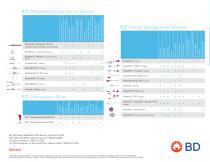
Catalog excerpts

PowerGlide Pro™ RT Catheter PowerMidline™ Catheter Provena™ Midline Catheter BD Intraosseous Driver Emergent access Passive needle safety Blood sampling Ergonomic design Manual Insertion Driver with battery life indicator Short dwell BD™ Intraosseous Powered Driver BD™ Intraosseous Manual Driver PowerPICC™ Provena™ Catheter Groshong™ NXT PICC Catheter HickmanTM / LeonardTM / BroviacTM CVC PowerGlide Pro™ Catheter VeloCath™ Catheter PowerPICC™ Catheter PowerGroshong™ PICC Catheter AccuCath Ace™ Catheter Totally implanted Sherlock™ TLS / Sherlock™ 3CG TCS compatible Cue™ Needle-Tracking System compatible Blood sampling Early flashback indication Seldinger technique / Modified technique Cue™ Needle-Tracking System Power injectable BD Nexiva™ Diffusics™ Closed IV Catheter Dual lumen Short dwell Integrated stabilization BD Nexiva™ Closed IV Catheter System Power injectable Integrated wire Shielded IV Catheter with Blood Control Technology BD® Central Vascular Access Devices Long dwell Blood control technology Integrated extension BD® Peripheral Vascular Access Devices Vascular Access Device Planning Infusion Therapy Standards of Practice PowerPort™ Implantable Ports PowerPortTM ClearVUETM Implantable Ports BD, 605 North 5600 West, Salt Lake City, Utah 84116 USA Main: 801.522.5000 Customer Service: 1.800.545.0890 Clinical Information: 1.800.443.3385 For Clinical Support on Ports and CVCs, please contact 1-800-555-7422. bd.com BD, the BD Logo, AccuCath Ace, Autoguard, Broviac, ClearVue, Cue, Diffusics, Groshong, Hickman, Insyte, Nexiva, PowerGlide, PowerGlide Pro, PowerGroshong, PowerHohn, PowerMidline, PowerLine, PowerPICC, PowerPort, Provena, Sherlock, SOLO, VeloCath, Vialon are trademarks of Becton, Dickinson and Company or its affiliates. © 2020 BD. All rights reserved. BD-16131(4/2020) The appropriate type of vascular access device (VAD), peripheral or central, is selected to accommodate the patient’s vascular access needs based on the prescribed therapy or treatment regimen; anticipated duration of therapy; vascular characteristics; and patient’s age, comorbidities, history of infusion therapy, preference for VAD location, and the ability and resources available to care for the device. The most appropriate VAD device selection should occur as a collaborative process between the clinicians, patient and patient caregivers. The device selected should be the smallest outer diameter with the fewest number of lumens and be the least invasive for the prescribed therapy. Consideration of peripheral vein preservation should always be a factor in VAD decision making. INS Standards of Practice 26.1, 26.2, 26.3, 26.4 page S51 Selecting the appropriate device for a patient is a critical part of a clinician’s job. These materials are being provided for your information only and are not a substitute for clini
Open the catalog to page 1
Considerations for vascular access device selection Diagnosis Comorbidities Visible/palpable vein History of difficult access Chronological age Developmental age Infusion therapy process map Patient education and preference Successful completion of prescribed therapy Minimize therapy-related complications Minimize the number of venipunctures Minimize supply and labor costs Patient satisfaction Reduced needlestick injuries and blood exposure to healthcare workers Patient considerations Expected outcomes Anatomical limitations/considerations - AV fistula/graft - Limb...
Open the catalog to page 2
Considerations for vascular access device selection Diagnosis Comorbidities Visible/palpable vein History of difficult access Chronological age Developmental age Infusion therapy process map Patient education and preference Successful completion of prescribed therapy Minimize therapy-related complications Minimize the number of venipunctures Minimize supply and labor costs Patient satisfaction Reduced needlestick injuries and blood exposure to healthcare workers Patient considerations Expected outcomes Anatomical limitations/considerations - AV fistula/graft - Limb...
Open the catalog to page 3
PowerGlide Pro™ RT Catheter PowerMidline™ Catheter Provena™ Midline Catheter BD Intraosseous Driver Emergent access Passive needle safety Blood sampling Ergonomic design Manual Insertion Driver with battery life indicator Short dwell BD™ Intraosseous Powered Driver BD™ Intraosseous Manual Driver PowerPICC™ Provena™ Catheter Groshong™ NXT PICC Catheter HickmanTM / LeonardTM / BroviacTM CVC PowerGlide Pro™ Catheter VeloCath™ Catheter PowerPICC™ Catheter PowerGroshong™ PICC Catheter AccuCath Ace™ Catheter Totally implanted Sherlock™ TLS / Sherlock™ 3CG TCS compatible Cue™ Needle-Tracking...
Open the catalog to page 4All Bard Access Systems catalogs and technical brochures
-
hohn
3 Pages
-
POLY RADPICC® CATHETERS
4 Pages
-
PowerPICC
4 Pages
-
HemoSplit
2 Pages
-
INTRODUCER SETS
1 Pages
-
X-Port? Implantable Port
2 Pages
-
Port Access Kit
2 Pages
-
Bard® Winged Infusion Set
1 Pages
-
Maximal Barrier Kit
2 Pages
-
Site-Scrub® IPA Device
4 Pages
-
Inservice Poster
2 Pages
-
Groshong® Catheters
3 Pages






























